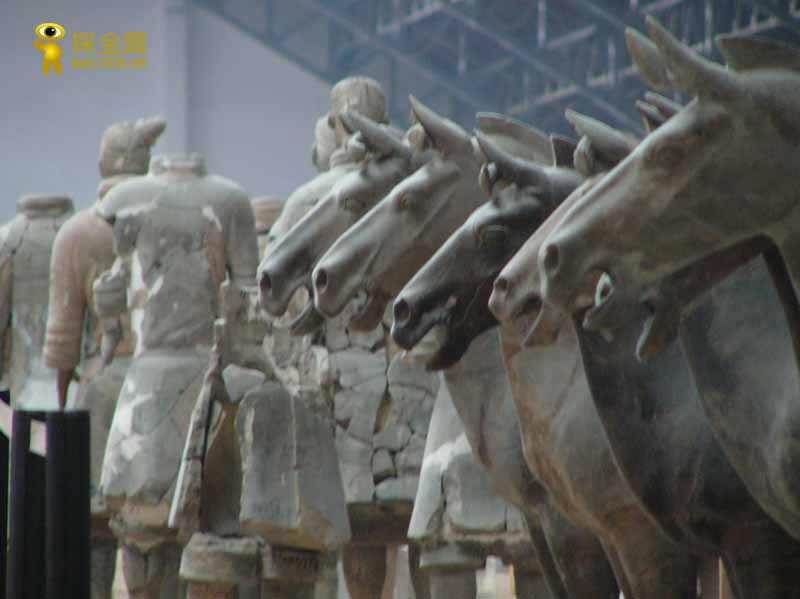
October 21 news reporters from the opening of the Museum of Qin Shi Huang Mausoleum "Terracotta dream - to tell the story happened here," the exhibition site informed that, after two generations old and new archaeological team's hard work, Qin Shi Huang Mausoleum archaeological exploration and the overall layout The excavation and excavation work was fruitful. In the area of ​​the 56.25 square kilometer Qin Shihuang Mausoleum site, archeologists ascertained 149 funerary pits and 196 funerary tombs of different natures and connotations, as well as the temples, houses, thresholds, and corridors. The bases of the building, such as the Temple Monastery, are millions of square meters, and more than 50,000 precious cultural relics have been unearthed.
It was also informed that in the last year sponsored Chinese Academy of Social Archeology Forum, integrated Emperor Qin Shihuang Museum 4 initiative archaeological excavation of "Emperor Qin Shi Huang Mausoleum archaeological" won the "2013 China Archaeological Discoveries," which four archaeological excavations Including the excavation of the K9901 funerary crater from 2011 to 2013, the excavation of the inner city building ruins of the Qinshihuang cemetery, and the excavation of the burial site from the burial site in the cemetery in 2013 and the excavation of T23 in Pit No. 1 of the Terracotta Warriors and Horses.
The reporter was informed that in the overall excavation of the funerary burial pit at K9901, the Qinling Museum studied the shape, structure and relics of the pit, and more than 1,200 pieces of pottery figurines were newly unearthed in holes No. 2 and No. 3. They belonged to 30. A number of individual pottery objects, in addition, also found a large bronze bronze tripod, oval stone tools and a large number of lead blocks and other items. Experts said that this was the first discovery in the archaeological site of Emperor Qin Shihuang's Mausoleum. A large number of Tao He is currently undergoing further repairs. The study found that the pit has a synchronous relationship in the construction and destruction of the Qin Shi Huang Mausoleum. It has been ascertained that the total area of ​​the ruins of the inner city of the Qin Shi Huang Mausoleum was 170,000 square meters. During the excavation of a small burial crater in the inner city of the cemetery last year, although the tomb skeleton was not found in the burial chamber, the burial female bones were found in the tomb. This has provided direct archaeological evidence for further understanding of the brutal handling of the harems of the Second World War after Emperor Qin Shi Huang's death, and has also added new insights into the regulation of Emperor Qin Shihuang’s tomb.
The Mausoleum of Emperor Qin Shi Huang is China's first royal cemetery. Among the nearly 100 imperial mausoleums in China, it is known for its large scale and rich burial. The core area of ​​the site, centered on closed earth, has reached 2.13 square kilometers. The Qin Shi Huang Mausoleum is a reproduction of the ground kingdom from underground. Archaeological exploration was informed that there are two different worlds inside and outside the city wall around the tomb of Emperor Qin Shi Huang, they are a symbol of Miyagi and outer city; tall mound and underground palace, a symbol of the Emperor Qin palace during his lifetime; the rest room and Piandian, a symbol of Qin Shi Huang during his lifetime is sleep and rest The banquet place; and all kinds of funerary pits are also the epitome of what Qin Shihuang had enjoyed and had before his lifetime.
In recent years, the Qinling archaeology and its research achievements have been fruitful. The “Reinforcing Techniques for the Qinling Mausoleum Cars and Horses†and the “Research on the Protection Techniques of the Qin-Qi Paintings†won the second prize for the National Science and Technology Progress Award; the Qin Shi Huang Terracotta Warriors and Horses archaeological project received “ "The Little Nobel Prize," the "Prince of Asturias Social Science Prize," is the first time that China has won this award.
Exploration Network Ancient Tomb Detection Solution:
  Â